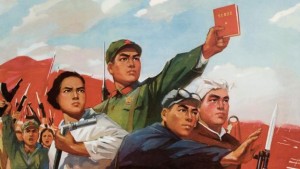
Propaganda poster for the Chinese People’s Liberation Army, with Red Army and Red Guard members charging forward holding Mao Zedong¬ís Little Red Book (color lithograph), 1971. (Photo by GraphicaArtis/Getty Images)
The Red Army emerged during the Cultural Revolution of Chairman’s Mao reign over China. This rebellion is marked by a time of violence, destruction and loyalty to the Communist ideology sparked by Mao. There is a strong sartorial influence during this time period when the Mao suit was popular and the Red Guard uniform was widely adopted. In this WordPress, I will analyze the dress of this propaganda picture and the symbolic meaning behind the surface layer. Finally, I will conclude that the author of this picture successfully creates an inviting propaganda poster through their intentional decisions with color choice, character expression and symbolic meaning.
Starting with my first observations, or denotations, I notice the dominate red color that is a typical representation of this time period. Also, in the foreground of the picture are four people, a woman and three men who are presumably part of Mao’s Red Army fighting for his cause. They each wear a different color: green, white, blue and brown. The woman in white is holding a weapon as well as the man in blue. The man in green holds out Mao’s Little Red Book. Behind them in the background we can see a crowd of people all rioting with weapons as well. The four in the front all have expressions of determination and look out into the distance heroically.
Looking deeper into the connotations of these observations, the dominant red color is a strong symbol of the Communist period. It is a powerful color and a good way to convey strength in a propaganda poster. Focusing on the four front members, each once represents a different variety of uniform. The man in green wears a military uniform, the woman wears white, a color of privilege and high status as she probably works in a lab. The man in blue is a worker, typically a factory worker and the man in brown represents the peasant population. By having all these people working together it shows the unity of the Revolution. Mao’s plan was to unite all the people of China regardless of gender or class. Their expressions are very telling as well. They look aggressive and determined to fight. By looking off into the distance they create a sense of heroism and make this propaganda poster appealing. It is successful in inviting people to want to join the movement.
how about pair the denotation with the connotation. for instance, the four figures (denotation) as the leading social-political subject (connotation); the uniform (denotation) that defines its social-political identity (connotation) ….
